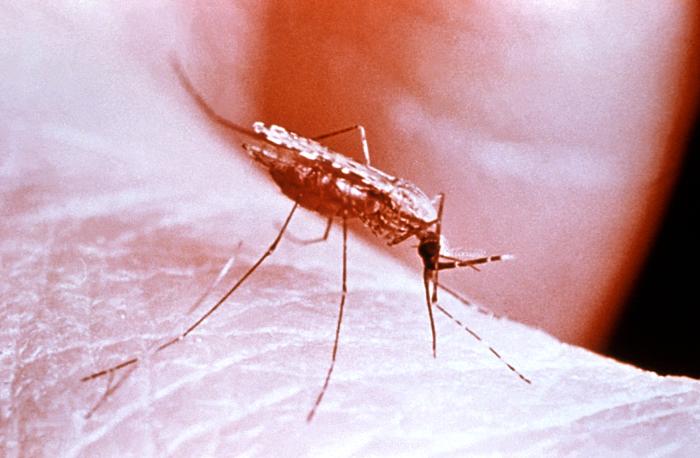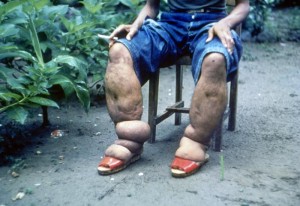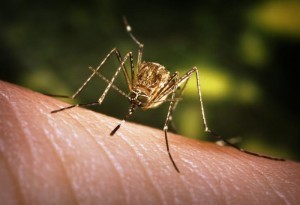Mosquitoes.
Day-in and day-out, we don’t think much about them except when they are buzzing by our ear. We swat at them as we would any other nuisance.
However, it has been said that mosquitoes cause more human suffering than any other organism — over one million people worldwide die from mosquito-borne diseases every year.

Image/CDC
Not only can they carry some of the most feared diseases known to humankind, they also transmit several diseases and parasites that dogs and horses are very susceptible to.
There are more than 3,000 species of mosquitoes, but the members of three bear primary responsibility for the spread of human diseases: Anopheles, Culex and Aedes spp.
Here I will go over 13 parasitic and viral diseases that humans can contract from a mosquito bite.
1. Malaria
Malaria, from the Italian for “bad air”, is caused by a parasite called Plasmodium, which is transmitted via the bites of infected Anopheles mosquitoes. In the human body, the parasites multiply in the liver, and then infect red blood cells.
In 2013 an estimated 198 million cases of malaria occurred worldwide and 500,000 people died, mostly children in the African Region.
Symptoms of malaria include fever, headache, and vomiting, and usually appear between 10 and 15 days after the mosquito bite. If not treated, malaria can quickly become life-threatening by disrupting the blood supply to vital organs. In many parts of the world, the parasites have developed resistance to a number of malaria medicines.
2. Lymphatic filariasis (elephantiasis)

There are three different filarial species (nematode parasites) that can cause lymphatic filariasis in humans. Most of the infections worldwide are caused by Wuchereria bancrofti. In Asia, the disease can also be caused by Brugia malayi and Brugia timori.
Lymphatic filariasis affects over 120 million people in 73 countries throughout the tropics and sub-tropics of Asia, Africa, the Western Pacific, and parts of the Caribbean and South America.
A wide range of mosquitoes can transmit the parasite, depending on the geographic area. In Africa, the most common vector is Anopheles and in the Americas, it is Culex quinquefasciatus. Aedes and Mansonia can transmit the infection in the Pacific and in Asia.
The painful and profoundly disfiguring visible manifestations of the disease, lymphoedema, elephantiasis and scrotal swelling occur later in life and lead to permanent disability. These patients are not only physically disabled, but suffer mental, social and financial losses contributing to stigma and poverty.
3. Yellow fever
Yellow fever virus is found in tropical and subtropical areas in South America and Africa. There are an estimated 200,000 cases of yellow fever, causing 30,000 deaths, worldwide each year, with 90% occurring in Africa.
The virus is transmitted to humans primarily through the bite of infected Aedes or Haemagogus species mosquitoes. Mosquitoes acquire the virus by feeding on infected primates (human or non-human) and then can transmit the virus to other primates (human or non-human).
The majority of persons infected with yellow fever virus have no illness or only mild illness. However, roughly 15% of cases that do develop symptoms progress to develop a more severe form of the disease. The severe form is characterized by high fever, jaundice, bleeding, and eventually shock and failure of multiple organs.
Vaccination is the most important preventive measure against yellow fever.
4. West Nile fever

West Nile Virus (WNV) was first isolated in a woman in the West Nile district of Uganda in 1937. In 1999 a WNV circulating in Israel and Tunisia was imported in New York and is now ever present in the US annually.
In 2014, there were more than 2,200 cases in the US, including nearly 100 deaths.
WNV has been detected in dozens of mosquito species.
Up to 80 percent of people who become infected with West Nile virus do not develop any symptoms.
About 20% of people who become infected with WNV will develop West Nile fever. Symptoms include fever, headache, tiredness, and body aches, nausea, vomiting, occasionally with a skin rash (on the trunk of the body) and swollen lymph glands.
Less than 1% of people who are infected will develop a serious neurologic illness such as encephalitis or meningitis (inflammation of the brain or surrounding tissues). Of this number, about 10 percent will die.
5. Dengue fever
Dengue virus is transmitted by female mosquitoes mainly of the species Aedes aegypti and, to a lesser extent, A. albopictus.
As many as 400 million people are infected yearly. Dengue is caused by any one of four related viruses transmitted by mosquitoes.
The principal symptoms of dengue fever are high fever, severe headache, severe pain behind the eyes, joint pain, muscle and bone pain, rash, and mild bleeding (e.g., nose or gums bleed, easy bruising). Generally, younger children and those with their first dengue infection have a milder illness than older children and adults.
Severe dengue (dengue hemorrhagic fever/dengue septic shock) is a potentially deadly complication due to plasma leaking, fluid accumulation, respiratory distress, severe bleeding, or organ impairment.
6. Chikungunya
Chikungunya is a mosquito borne virus that has been identified in over 60 countries in Asia, Africa, Europe and the Americas. In late 2013, chikungunya virus was found for the first time in the Americas on islands in the Caribbean, since then, well more than 1 million local transmission cases have been reported.
Chikungunya is a viral disease transmitted by the bite of infected mosquitoes such as Aedes aegypti and Aedes albopictus. It can cause high fever, join and muscle pain, and headache.
Chikungunya does not often result in death, but the joint pain may last for months or years and may become a cause of chronic pain and disability.
There is no specific treatment for chikungunya infection, nor any vaccine to prevent it. Pending the development of a new vaccine, the only effective means of prevention is to protect individuals against mosquito bites.
7. Zika fever
The Zika virus is also transmitted through the bite of an infected Aedes species mosquito, the same mosquitoes that spread dengue and chikungunya viruses.
If symptomatic, symptoms are generally mild–fever, rash, joint pain, or red eyes. Severe disease requiring hospitalization is uncommon and deaths have not been reported.
Outbreaks of Zika virus disease (or Zika) previously have been reported in tropical Africa, Southeast Asia, and the Pacific Islands. Zika virus likely will continue to spread to new areas. In May 2015, the Pan American Health Organization (PAHO) issued an alert regarding the first confirmed Zika virus infections in Brazil.
8. Ross River fever
Ross River virus disease (RRVD) is a mosquito borne virus. About 55%–75% of people who are infected do not feel sick, according to the US Centers for Disease Control and Prevention (CDC).
For those who do feel sick, symptoms of RRVD include joint pain and swelling, muscle pain, fever, tiredness, and rash. Most patients recover within a few weeks, but some people experience joint pain, joint stiffness or tiredness for many months.
RRVD infection cannot be spread from person to person. It is found throughout Australia, Papua New Guinea, parts of Indonesia and the western Pacific Islands.
9. Eastern Equine Encephalitis
Eastern Equine Encephalitis (EEE) is spread to horses and humans by infected mosquitoes, including several Culex species and Culiseta melanura.
Symptoms of EEE disease often appear 4 to 10 days after someone is bitten by an infected mosquito.
EEE is a more serious disease than West Nile Virus (WNV) and carries a high mortality rate for those who contract the serious encephalitis form of the illness. Symptoms may include high fever, severe headache, stiff neck, and sore throat. There is no specific treatment for the disease, which can lead to seizures and coma.
10. Japanese Encephalitis
Japanese encephalitis (JE) is the most important cause of viral encephalitis in Asia. About 68,000 clinical cases are reported annually. It usually occurs in rural or agricultural areas, often associated with rice farming.

JE virus is transmitted to humans through the bite of infected Culex species mosquitoes, particularly Culex tritaeniorhynchus.
Most JE virus infections are mild (fever and headache) or without apparent symptoms, but approximately 1 in 250 infections results in severe disease characterized by rapid onset of high fever, headache, neck stiffness, disorientation, coma, seizures, spastic paralysis and death. The case-fatality rate can be as high as 30% among those with disease symptoms.
There is a protective vaccine against Japanese encephalitis virus.
11. La Crosse Encephalitis
La Crosse encephalitis virus (LACV) is transmitted to humans by the bite of an infected mosquito. Most cases of LACV disease occur in the upper Midwestern and mid-Atlantic and southeastern states.
It was reported first in 1963 in LaCrosse, Wisconsin and the vector is thought to be a specific type of woodland mosquito (Aedes triseriatus) called the tree-hole mosquito.
Among people who become ill, initial symptoms include fever, headache, nausea, vomiting, and tiredness. Some of those who become ill develop severe neuroinvasive disease (disease that affects the nervous system).
In rare cases, long-term disability or death can result from La Crosse encephalitis.
12. St. Louis Encephalitis
St. Louis Encephalitis (SLE) is transmitted from birds to man and other mammals by infected mosquitoes (mainly some Culex species). SLE is found throughout the United States, but most often along the Gulf of Mexico, especially Florida.
Most persons infected with SLEV have no apparent illness. Initial symptoms of those who become ill include fever, headache, nausea, vomiting, and tiredness. Severe neuroinvasive disease (often involving encephalitis, an inflammation of the brain) occurs more commonly in older adults. In rare cases, long-term disability or death can result.
13. Western Equine Encephalitis
Western Equine Encephalitis (WEE) is found west of the Mississippi including parts of Canada and Mexico. The primary vector is Culex tarsalis.
As with EEE a vaccine is available for horses against WEE but not for humans.


Mosquitoes do not transmit diseases, they transmit pathogens that sometimes cause these diseases.
Don’t try to be technical, if you with to do that comment on a medical site, since the common person is far more familiar with the word “disease” than pathogen!
Guy: Pathogens are infectious microorganism or agent, such as a virus, bacterium, protozoan, prion, viroid, or fungus. Sine if these organisms responsible for mosquito transmitted diseases are WORMS, aka parasites! If you studied microbiology judiciously, you’d know that!
lets find a disease that kills mosquitos and start giving it to them
smart thinking! 🙂 if we had me re people use there brain in situations like this we would be ok….
Why does the government not spray for mosquitoes anymore considering there’s so many pathogens being released by them are they trying to thin out the herd
i lived in a Philippine village for a long time and I offered to spray the village once a month to kill mosquitoes but my wife and the people refused to let me do it because they said the chemical did not smell good how can you help people that think like they do live there and see they only want money nothing else matters to them and they will do anything to get it you can lead a horse to water but you cannot make it drink they will never change they like to live in rubbish
Hi ernie bayne ,
The most easiest steps to reduce the Mosquito comming under the leaves of a plants located in a public garden ,if you are interested to eliminate this kind of problems rapidly and save trees from the germs then the best way to provide a pure water to all the trees of a garden according to the passage of a time and also spread a medicine of mosquitoes germs killer with the help of harvest roller which help you to eliminate the mosquitos germs from all the plants of a garden in a very speedily.my suggestion is to you to take care of trees .
Thanks .
anemia
Can they leave a parasite in your body